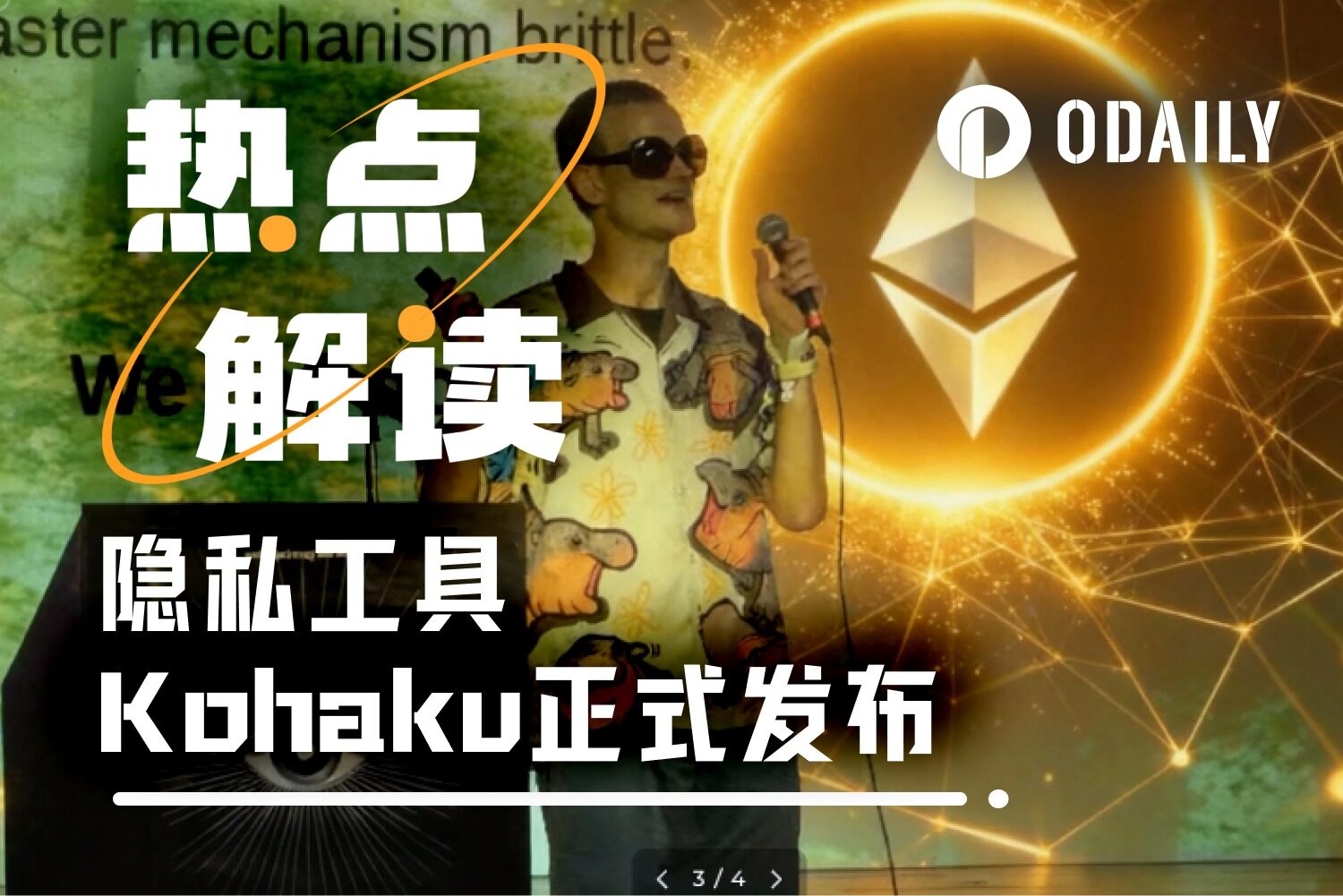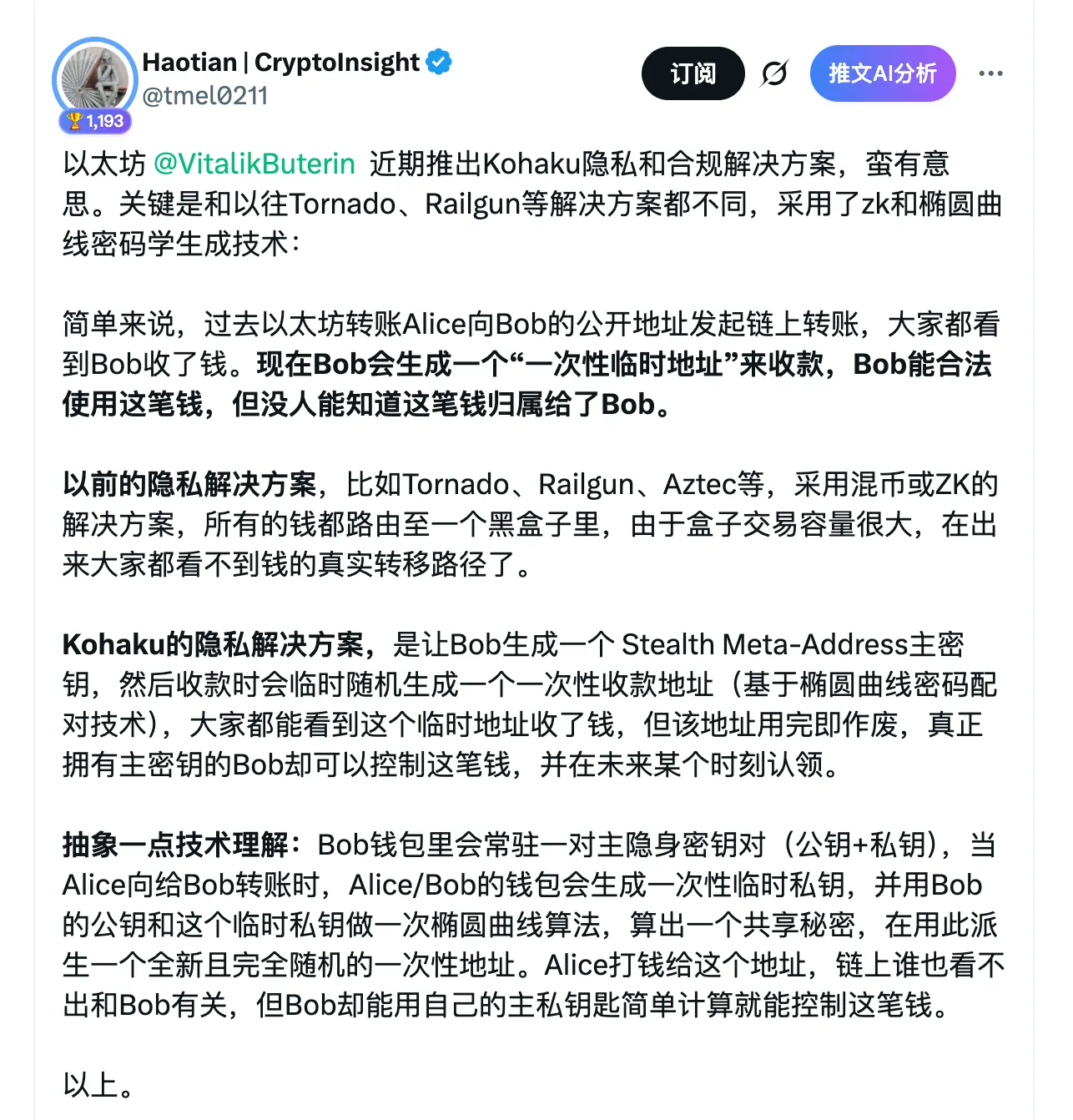Original | Odaily Planet Daily (@OdailyChina)
Author | Ethan (@ethanzhangweb3)
On November 16, 2025, at the main stage of Devcon 2025, when Vitalik demonstrated Kohaku, my first reaction was: "Another privacy narrative?"
Indeed, the privacy sector has been gaining momentum recently: from the seizure of 120,000 BTC by the U.S. judicial authorities in October to the sentencing of Qian Zhimin, the main perpetrator of a money laundering case involving 60,000 BTC in November, the topic of on-chain privacy has been continuously discussed; ZEC surged from $50 to $603, driving the entire privacy sector to take off.
As a result, many people naturally view Kohaku as another privacy product born out of this trend.
But it is not. Kohaku is not an enhanced version of Tornado, nor is it a repackaging of a new ZK protocol—it targets a foundational infrastructure gap that has been overlooked for a full decade: the wallet entry layer of Ethereum has never truly supported privacy.
Since 2015, Ethereum has made continuous advancements in privacy technology, but the wallet layer has always been a shortcoming: reliance on RPC, fragmented addresses, and the disconnect between privacy and main accounts… Various obstacles have kept cryptographic achievements confined to a "small circle of use" for a decade. In other words, Ethereum lacks privacy technology, but what it lacks is an entry point that mainstream users can utilize.
What Kohaku aims to do is to bridge this gap.
What exactly is Kohaku?

Kohaku is not a wallet, nor is it a new privacy protocol, but an open-source "wallet privacy operating system kernel." Its official name is Kohaku Privacy Wallet Framework, led by the Ethereum Foundation's Privacy Cluster (a team of 47 people). The roadmap was first announced on October 9, 2025, and was publicly demonstrated by Vitalik at the Ethereum Developer Conference in Argentina on November 16-17.
According to the most precise official definition (EF official X): "The Ethereum Foundation is proud to build Kohaku, a set of primitives that enables wallets to be secure and to process private transactions while minimizing dependencies on trusted third parties."
In simpler terms: it provides all wallet developers with a box of "privacy and security LEGO blocks." By integrating it, wallets can natively possess capabilities such as default privacy, trustless state reading, and compliance module proof, without relying on centralized RPCs like Infura or Alchemy, nor needing to prepare a separate "independent wallet" for privacy scenarios.
According to the official roadmap, Kohaku's architecture is divided into three layers:
The first layer is the SDK, providing privacy and security primitives for wallets; the second layer is a reference implementation, a browser extension aimed at advanced users to demonstrate how these primitives can be combined; the third layer is a plugin system, allowing wallets to enable different modules on demand as if calling system APIs. In other words, Kohaku is not Metamask 2.0, nor is it a "more private wallet," but a set of foundational specifications defining basic capabilities for the entire wallet ecosystem.
How does it protect privacy?
For Kohaku's privacy protection mechanism, cryptography community researcher @tmel0211 explained the working principle of stealth addresses with a straightforward example, which I will slightly supplement and correct here:
In traditional Ethereum transfers, Alice directly sends money to Bob's public address, and the entire network can see "Bob received this money."
The stealth address solution supported by Kohaku (such as ERC-7811) is completely different:
- Bob's wallet holds a pair of permanent Stealth Meta-Addresses (main public key + main private key), where the main public key can be safely shared.
- Each time a payment is received, Alice and Bob's wallets jointly generate a temporary random private key, compute a shared secret through elliptic curve pairing (EC-pairing), and derive a brand new, one-time receiving address from it.
- Alice sends funds to this one-time address, and on-chain, it will only show "a new unknown address received a sum of money," with no way to establish any connection to Bob's main identity.
- Bob can identify and control these funds in real-time by scanning locally with his main private key—this entire process does not require a mixing pool and does not need to wait for an additional "claim" step.

In other words, on-chain, it is impossible to determine who owns this asset, but the entire process does not require entering a black box like Tornado.
Stealth addresses are just one of many privacy primitives in Kohaku. Through a modular SDK, these capabilities can be seamlessly integrated into different wallets, allowing developers to achieve default privacy at a very low cost. According to the roadmap, Kohaku will also integrate Railgun (fund shielding + ZK proof of innocence), Privacy Pools (in development, transaction obfuscation + compliance pool), Helios light client + PIR/TEE (privacy reading of on-chain state), per-dApp address isolation, P2P broadcasting, and post-quantum emergency switching capabilities.
These components together form a "wallet-level privacy execution environment," covering the complete chain from requests, to reading, to transfers, and then to compliance proofs.
What operational changes are there?
Before Kohaku, privacy features were typically designed as plugin-style supplements rather than default capabilities of wallets.
In the past: You want privacy → Open a new wallet → New mnemonic → Switch back and forth between different addresses → Assets get split → Ultimately still rely on centralized RPC.
Now (Kohaku's target state): When you open any wallet that supports Kohaku (MetaMask, Rainbow, Trust Wallet…), it defaults to privacy mode; you can manage both public and private assets using the same mnemonic, multi-signature as usual, dApp automatically isolates addresses, and if necessary, you can generate compliance module proofs with one click. The entire process is verified locally, with nodes only knowing you are connected but not knowing what you are doing, viewing, or transferring.
A more intuitive experience difference is: you no longer need to "switch identities." For example, when you first connect to a dApp, the wallet will automatically generate a separate address for it, avoiding behavior linkage; when you need to send a transfer, the wallet will default to using the stealth address path and prompt whether to include a privacy proof if necessary—you don’t even need to know which protocol is being used behind the scenes, nor do you need to switch to another "privacy wallet" to handle it. In the future, if certain DeFi protocols are compatible with Kohaku, this "seamless privacy" will extend from the entry point to some interaction processes.
In other words, Kohaku aims to merge the previously separate actions of "using a wallet" and "enabling privacy" into one action. This mechanism is currently in the testing phase, with integration examples of existing wallets showcased at the conference and available for actual online experience.
Of course, the project is still in its early stages (some toolkits are still marked as "in development" on the official GitHub), but the core module Railgun is already testable, and Privacy Pools and Tornado toolkits are being improved; the reference implementation extension has already been able to run through the complete process, and all code repositories have been made public.
There are advancements, but also limitations
Essentially, Kohaku is not an upgraded version of a privacy protocol, but rather organizes the privacy capabilities scattered in Ethereum's research over the past decade into a "lower-level interface" that wallets can directly inherit, filling the long-missing entry layer. Vitalik mentioned on-site that he never expected multi-signature wallets to become so popular—what truly popularizes technology is never the cryptography itself, but whether "the entry is user-friendly enough." Kohaku replicates this path, transforming privacy from "an additional wallet" into "a default wallet."
However, its limitations are equally clear: Kohaku's privacy only covers accounts and transfers; once assets enter DeFi protocols, all operations remain fully exposed—this is determined by the EVM architecture, not a problem that wallets can solve. This is also why it can be quickly implemented: it avoids the structural challenges of the execution environment and prioritizes solving the one kilometer closest to the user.
Even so, Kohaku is still the true starting point of Ethereum's privacy system. It will not make Ethereum "invisible" overnight, but it is the first time that privacy has the potential to scale into mainstream wallets; it cannot solve the transparency of DeFi execution, but it finally makes the entry layer no longer a shortcoming after ten years. Whether privacy can penetrate into the contract execution layer is a question for the next generation of Ethereum and the next generation of execution environments, and is no longer a matter concerning wallets.
免责声明:本文章仅代表作者个人观点,不代表本平台的立场和观点。本文章仅供信息分享,不构成对任何人的任何投资建议。用户与作者之间的任何争议,与本平台无关。如网页中刊载的文章或图片涉及侵权,请提供相关的权利证明和身份证明发送邮件到support@aicoin.com,本平台相关工作人员将会进行核查。




